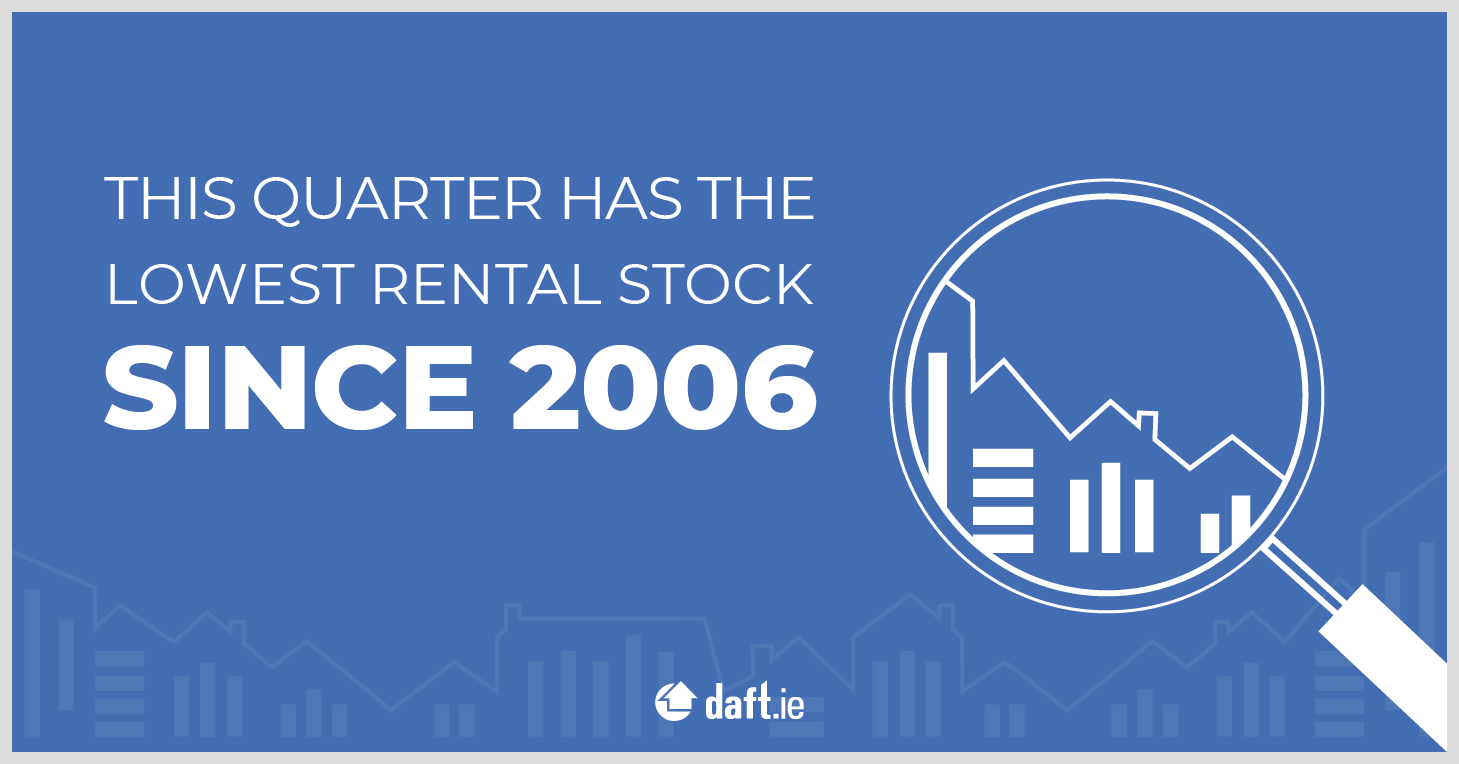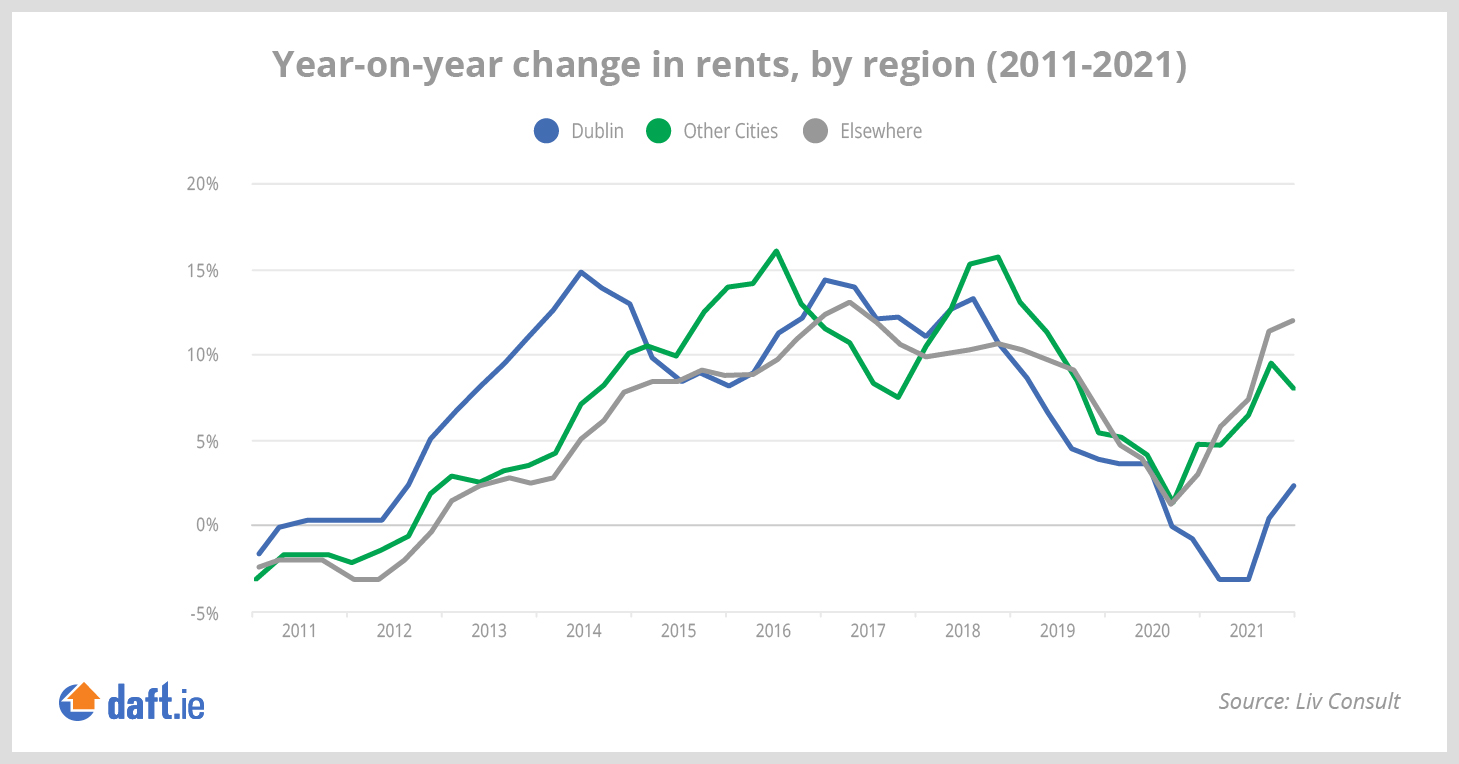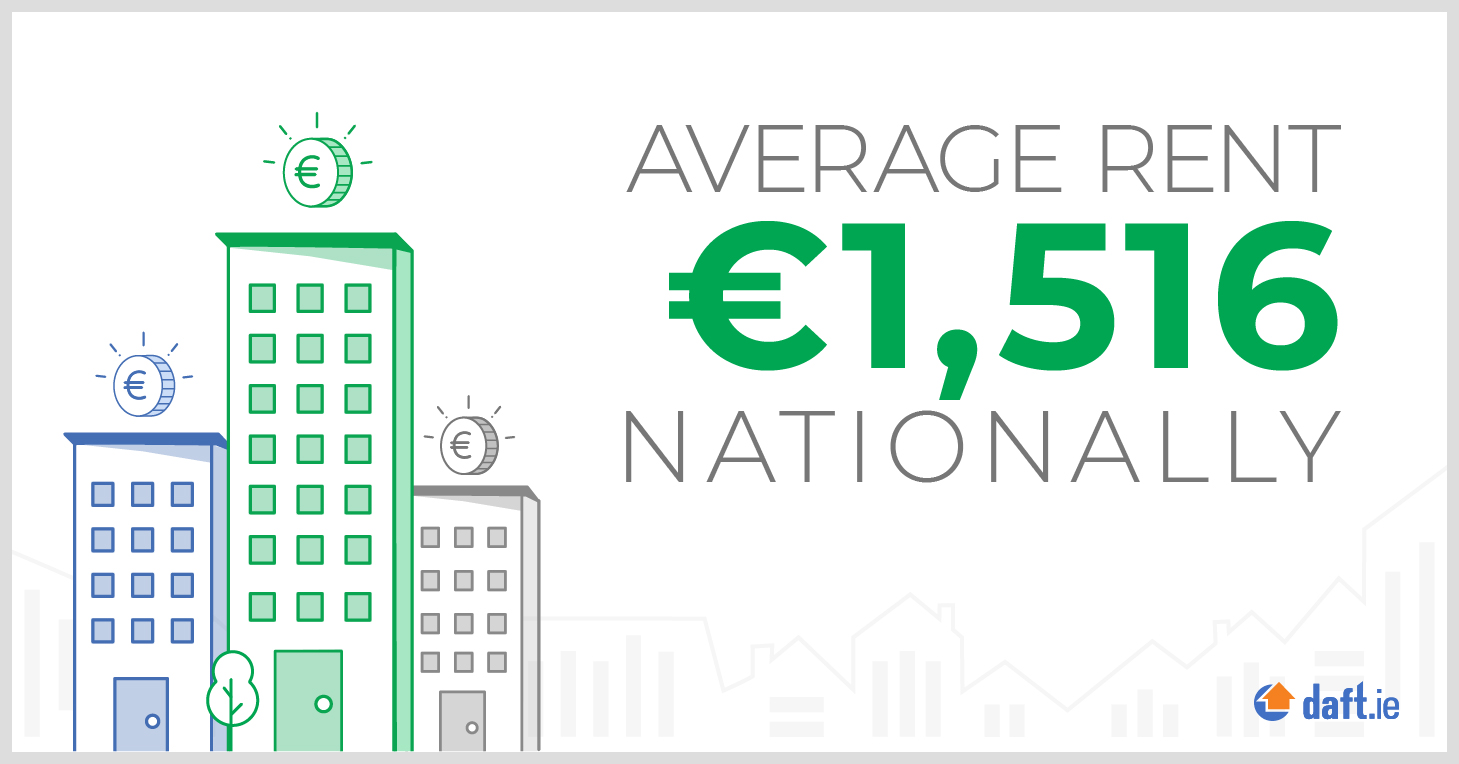Irish Rental Report Q3 2021 | Daft.ie
Daft Reports
- Ronan Lyons (House Price, Q1 2024)
- Ronan Lyons (Rental Price, Q4 2023)
- Ronan Lyons (House Price, Q4 2023)
- Ronan Lyons (Rental Price, Q3 2023)
- Ronan Lyons (House Price, Q3 2023)
- Ronan Lyons (Rental Price, Q2 2023)
- Ronan Lyons (House Price, Q2 2023)
- Ronan Lyons (Rental Price, Q1 2023)
- Ronan Lyons (House Price, Q1 2023)
- Ronan Lyons (Rental Price, Q4 2022)
- Ronan Lyons (House Price, Q4 2022)
- Ronan Lyons (Rental Price, Q3 2022)
- Ronan Lyons (House Price, Q3 2022)
- Ronan Lyons (Rental Price, Q2 2022)
- Ronan Lyons (House Price, Q2 2022)
- Ronan Lyons (Rental Price, Q1 2022)
- Ronan Lyons (House Price, Q1 2022)
- Ronan Lyons (Rental, Q4 2021)
- Ronan Lyons (House Price, Q4 2021)
- Ronan Lyons (Rental, Q3 2021)
- Ronan Lyons (House Price, Q3 2021)
- Ronan Lyons (Rental, Q2 2021)
- Ronan Lyons (House Price, Q2 2021)
- Ronan Lyons (Rental, Q1 2021)
- Ronan Lyons (House Price, Q1 2021)
- Ronan Lyons (Rental, Q4 2020)
- Ronan Lyons (House Price, Q4 2020)
- Ronan Lyons (Wealth, H2 2020)
- Ronan Lyons (Rental, Q3 2020)
- Ronan Lyons (House Price, Q3 2020)
- Ronan Lyons (Housing, July 2020)
- Ronan Lyons (Housing, June 2020)
- Ronan Lyons (Housing, May 2020)
- Ronan Lyons (Rental, Q1 2020)
- Ronan Lyons (House Price, Q1 2020)
- Ronan Lyons (Rental, Q4 2019)
- Ronan Lyons (House Price, Q4 2019)
- Ronan Lyons (Wealth, H2 2019)
- Ronan Lyons (Rental, Q3 2019)
- Ronan Lyons (House Price, Q3 2019)
- Pierre Yimbog (Rental, Q2 2019)
- Ronan Lyons (House Price, Q2 2019)
- Ronan Lyons (Wealth, H1 2019)
- Ronan Lyons (Rental, Q1 2019)
- Ronan Lyons (House Price, Q1 2019)
- Ronan Lyons (Rental, Q4 2018)
- Ronan Lyons (House Price, Q4 2018)
- Ronan Lyons (Wealth, H2 2018)
- Ronan Lyons (Rental, Q3 2018)
- Ronan Lyons (House Price, Q3 2018)
- Shane De Rís (Rental, Q2 2018)
- Ronan Lyons (House Price, Q2 2018)
- Ronan Lyons (Wealth, 2018)
- Ronan Lyons (Rental, Q1 2018)
- Ronan Lyons (House Price, Q1 2018)
- Ronan Lyons (Rental, Q4 2017)
- Ronan Lyons (House Price, Q4 2017)
- Ronan Lyons (Rental, Q3 2017)
- Ronan Lyons (House Price, Q3 2017)
- Katie Ascough (Rental, Q2 2017)
- Ronan Lyons (Wealth, 2017)
- Ronan Lyons (House Price, Q2 2017)
- Ronan Lyons (Rental, Q1 2017)
- Ronan Lyons (House Price, Q1 2017)
- Ronan Lyons (Rental, Q4 2016)
- Ronan Lyons (House Price, Q4 2016)
- Ronan Lyons (Rental, Q3 2016)
- Ronan Lyons (House Price, Q3 2016)
- Ronan Lyons (School Report, 2016)
- Conor Viscardi (Rental, Q2 2016)
- Ronan Lyons (Rail Report, 2016)
- Ronan Lyons (House Price, Q2 2016)
- Ronan Lyons (Rental, Q1 2016)
- Ronan Lyons (House Price, Q1 2016)
- Ronan Lyons (Rental, Q4 2015)
- Ronan Lyons (House Price, Q4 2015)
- Ronan Lyons (Rental, Q3 2015)
- Ronan Lyons (House Price, Q3 2015)
- Marcus O'Halloran (Rental, Q2 2015)
- Ronan Lyons (House Price, Q2 2015)
- Ronan Lyons (Rental, Q1 2015)
- Ronan Lyons (House Price, Q1 2015)
- Ronan Lyons (Rental, Q4 2014)
- Ronan Lyons (House Price, Q4 2014)
- Ronan Lyons (Rental, Q3 2014)
- Ronan Lyons (House Price, Q3 2014)
- Domhnall McGlacken-Byrne (Rental, Q2 2014)
- Ronan Lyons (House Price, Q2 2014)
- Ronan Lyons (Rental, Q1 2014)
- Ronan Lyons (House Price, Q1 2014)
- Ronan Lyons (Rental, Q4 2013)
- Ronan Lyons (House Price, Q4 2013)
- Ronan Lyons (Rental, Q3 2013)
- Ronan Lyons (House Price, Q3 2013)
- Ronan Lyons (Rental, Q2 2013)
- Ronan Lyons (House Price, Q2 2013)
- Ronan Lyons (Rental, Q1 2013)
- Ronan Lyons (House Price, Q1 2013)
- Ronan Lyons (Rental, Q4 2012)
- Ronan Lyons (House Price, Q4 2012)
- Lorcan Sirr (Rental, Q3 2012)
- Padraic Kenna (House Price, Q3 2012)
- John Logue (Rental, Q2 2012)
- Ronan Lyons (House Price, Q2 2012)
- Barry O'Leary (Rental, Q1 2012)
- Seamus Coffey (House Price, Q1 2012)
- Joan Burton (Rental, Q4 2011)
- Ronan Lyons (House Price, Q4 2011)
- Philip O'Sullivan (Rental, Q3 2011)
- Sheila O'Flanagan (House Price, Q3 2011)
- Rachel Breslin (Rental, Q2 2011)
- Constantin Gurdgiev (House Price, Q2 2011)
- Cormac Lucey (Rental, Q1 2011)
- Eoin Fahy (House Price, Q1 2011)
- Lorcan Roche Kelly (Rental, Q4 2010)
- Ronan Lyons (House Price, Q4 2010)
- John Fitzgerald (Rental, Q3 2010)
- Patrick Koucheravy (House Price, Q3 2010)
- Gary Redmond (Rental, Q2 2010)
- Jim Power (House Price, Q2 2010)
- Jill Kerby (Rental, Q1 2010)
- Brian Lucey (House Price, Q1 2010)
- Michael Taft (Rental, Q4 2009)
- Alan McQuaid (House Price, Q4 2009)
- Dr. Charles J. Larkin (Rental, Q3 2009)
- Emer O'Siochru (House Price, Q3 2009)
- Ronan Lyons (Rental, Q2 2009)
- Oliver Gilvarry (House Price, Q2 2009)
- Brian Devine (Rental, Q1 2009)
- Dr. Liam Delaney (House Price, Q1 2009)
- Gerard O'Neill (Rental, Q4 2008)
- Ronan Lyons (House Price, Q4 2008)
- Dr. Stephen Kinsella (Rental, Q3 2008)
- Moore McDowell (House Price, Q3 2008)
- Shane Kelly (Rental, Q2 2008)
- Fergal O'Brien (House Price, Q2 2008)
- Eoin O'Sullivan (Rental, Q1 2008)
- Dermot O'Leary (House Price, Q1 2008)
- Dan O'Brien (Rental, Q4 2007)
- Frances Ruane (House Price, Q4 2007)
- John McCartney (Rental, Q3 2007)
- Ronnie O'Toole (House Price, Q3 2007)
- Ronan Lyons (Rental, Q2 2007)
- Constantin Gurdgiev (House Price, Q2 2007)
- Fintan McNamara (Rental, Q1 2007)
- Rossa White (House Price, Q1 2007)
- Geoff Tucker (Rental, Q4 2006)
- Damien Kiberd (House Price, Q4 2006)
- Pat McArdle (House Price, Q3 2006)
- Marc Coleman (House Price, Q2 2006)
- David Duffy (House Price, Q1 2006)
- Austin Hughes (House Price, Q4 2005)
- David McWilliams (House Price, Q2 2005)

10th Nov 2021
Back to abnormal but better times ahead
The figures in this latest Daft.ie Rental Report confirm a return to the pre-Covid-19 situation of weak supply in the face of very strong demand, due to underlying economic and demographic growth. Market rents rose by an average of 2.6% in the third quarter of 2021 nationwide, the third quarter in a row of rents rising by at least 2%.
Across the country as a whole, market rents are now 6.7% higher than a year ago ‐ the highest rate of inflation since early 2019. This rate is in line with the average rate over the last ten years, with rents rising by 6.7% since 2011 ‐ although this hides differences over time, with little to increase in rents in 2011/ 2012 and in 2020, and two double-digit peaks in inflation in mid-2014 and again in mid-2016.

That is, of course, not to say that nothing has changed. The graph accompanying this commentary shows the annual inflation rate for three top-level components of Ireland's rental market: Dublin, the four other cities, and the rest of the country. Dublin (in blue) clearly led the rest of the country in rent increase in the early 2010s, while the other cities peaked later and, if anything, more severely. The rest of the country had seen a peak in inflation around 2017 but overall rent increases had been below 10% before and around 10% for 2018 and 2019.
Figure 1. Year-on-year change in rents, by region (2011-2021)

The Covid-19 shock in early 2020 saw a halt to inflation everywhere but since then rents outside Dublin have risen by significantly more than rents in the capital. Compared to 2019, this does represent a dulling of the 'Dublin premium' ‐ rents in Dublin were 105% above rents outside the cities that year but are now just 80% above. But Dublin is still 80% more expensive than non-city rents, a higher premium than in 2006 or 2007. And, as the end of the first graph shows, inflation has returned to the Dublin rental market. Market rents in the capital are 2.5% higher than a year ago ‐ the highest rate of inflation since the start of the pandemic.
So Dublin, like elsewhere, has returned to the pre-covid19 norm of not enough rental homes given the numbers looking to rent. The data underpinning the Daft.ie Report are aggregated into 389 micro-markets. Across those 389, rents rose between the second and third quarters in 381. This is ‐ together with the second quarter of 2014 ‐ the highest number showing an increase on record, back to 2006.
Some will react to these trends with an understandable, if misplaced, search for easy solutions. A favourite is rent controls. But what this report covers is not the average rent paid by sitting tenants ‐ who benefit from rent controls ‐ but the average rent paid by new tenants, who invariably are not covered by such controls. While I can see the appeal of solving prices by simply making it illegal for prices to rise, it does nothing to address the reason why prices are rising ‐ the lack of rental accommodation.
The best analogy for housing prices is weight gain or loss. Prices rising is like weight gain. It reflects an on-going surplus of demand (calories) compared to supply (exercise). And, to keep with the analogy, Ireland's rental market has been putting on lots of weight in recent decades. Adjusting for wider inflation, rents rose only modestly between 1970 and 1995 ‐ with the average monthly rent in Dublin, in today's money terms, rising from €820 to €947 in a generation. Since then, they have more than doubled, to over €2,000 per month.

To make rental accommodation more affordable, we need to put in the hard effort of building lots of new rental homes. (This need not be the only solution, of course ‐ it is in addition to, rather than instead of, new homes for owner-occupiers and new social housing.) It is instructive that ‐ even within that 1995-2020 period of rising rents, rents were largely stable 1999-2008 and no higher in 2012 than in 1997. Why? Lots of new rental homes were built in the 2000s.
And, with this in mind, better times appear to be ahead for Dublin's rental market ‐ and perhaps the country's ‐ as we had into the mid-2020s. Figures compiled by LIV Consulting on the pipeline of rental homes in Ireland point to almost 44,000 rental homes due to come on stream between 2021 and 2026. Lest anyone think that these are the only homes being built, the country is likely to build at least 120,000 and probably closer to 140,000 homes in that period, so new rental homes are likely to represent less than one third of new homes.
The figures also point to a further 54,000 rental homes that have been proposed but are, as of now, not yet through the planning system. These would likely be built largely between 2025 and 2027, based on the capacity of the planning and construction systems. But it would mean that roughly 100,000 rental homes would be added in about a decade. If this sounds excessive, remember that it follows a decade in which effectively no new rental homes were built ‐ and we have seen the consequences of that.
The empirical evidence is unambiguous: more rental homes makes rental housing more affordable. Without new homes, we will still be discussing unaffordable rents in five years. With tens of thousands of new rental homes built, the city will have started catching up on the unmet housing need it has built up over decades ‐ and in particular during the 2010s. This is the choice facing Irish society.
